You’ve probably noticed that new car smell or the strong odor from fresh paint, but what you’re actually detecting are volatile organic compounds floating through your air. These invisible chemicals don’t just come from obvious sources—they’re quietly released by everyday items like cleaning products, furniture, and even your carpet. While your nose can catch some VOCs, it’s missing the dangerous ones that have no smell, and that’s where the real problem begins.
What Are Volatile Organic Compounds and Why They Matter
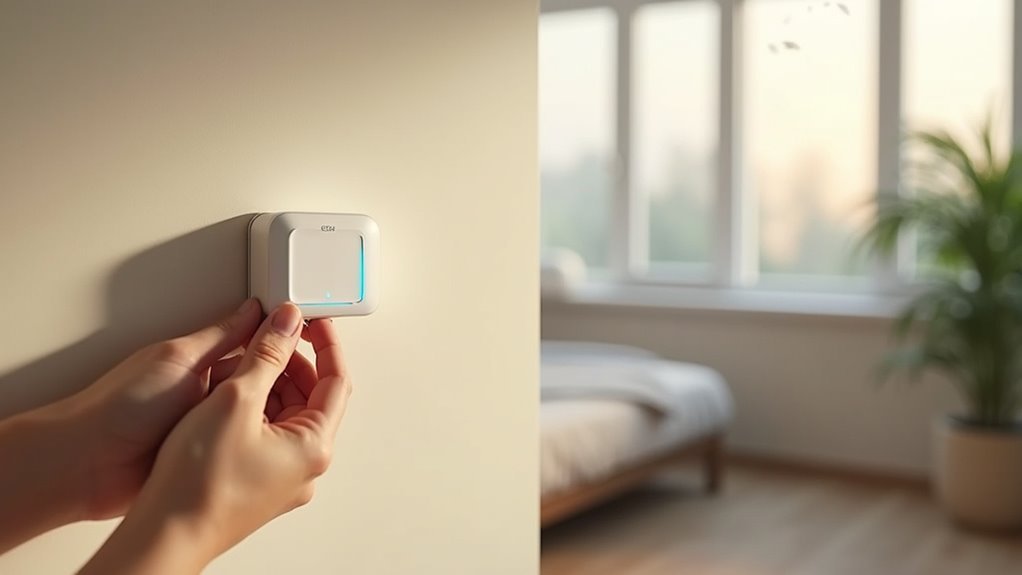
The invisible threat lurking in your home’s air might surprise you. VOCs are carbon-based chemicals with high vapor pressure at room temperature, constantly escaping from everyday products like paints, cleaning supplies, and fuels.
These harmful chemicals greatly impact your indoor air quality, creating an environment that’s potentially more polluted than outdoor air.
You’re exposed to these compounds daily, and the health effects can be immediate or long-term. Short-term exposure causes eye irritation, throat discomfort, and headaches.
However, prolonged exposure poses serious risks including liver damage, nervous system problems, and even cancer.
What’s particularly concerning is that there aren’t federal or state standards for acceptable VOC levels in homes, leaving you uncertain about your exposure risks and safety.
Common Sources of VOCs in Your Home
You’re surrounded by VOC sources throughout your home, from the paint on your walls to the cleaning spray under your kitchen sink.
Many household products and materials you use daily release these compounds into your indoor air, often without you realizing it.
Understanding both obvious and hidden VOC sources helps you make informed decisions about what to monitor with your sensors.
Household Products and Materials
Hidden culprits lurk throughout your home, silently releasing volatile organic compounds into the air you breathe daily. Your household products contribute greatly to indoor air pollution and health risks.
Paints, varnishes, and adhesives continuously emit VOCs long after application, while cleaning supplies containing solvents release harmful chemicals during and after use.
Your new furniture, carpets, and mattresses off-gas synthetic materials, with peak emissions occurring in the first weeks.
Tobacco smoke creates a complex mixture of lingering VOCs that contaminate your environment.
Even your home office equipment like printers and copiers add to cumulative VOC exposure during operation.
These everyday items create an invisible chemical cocktail that impacts your air quality and well-being.
Hidden VOC Sources
Beyond these obvious contributors, numerous unexpected items in your home release VOCs without your awareness.
Your office printer and copier emit harmful compounds during operation, especially in poorly ventilated spaces.
New mattresses, furniture, and carpets continue off-gassing VOCs for months or years after purchase, greatly impacting indoor air quality.
Personal care items like deodorants and air fresheners contain VOCs that cause respiratory irritation.
Even dried paint and varnish on your walls continue releasing these chemicals long after application.
Tobacco smoke leaves lingering VOCs that particularly threaten children and non-smokers.
These hidden sources create constant exposure to VOCs, making it difficult to identify why your indoor air quality remains poor despite your efforts to maintain a clean home environment.
Health Risks Associated With VOC Exposure
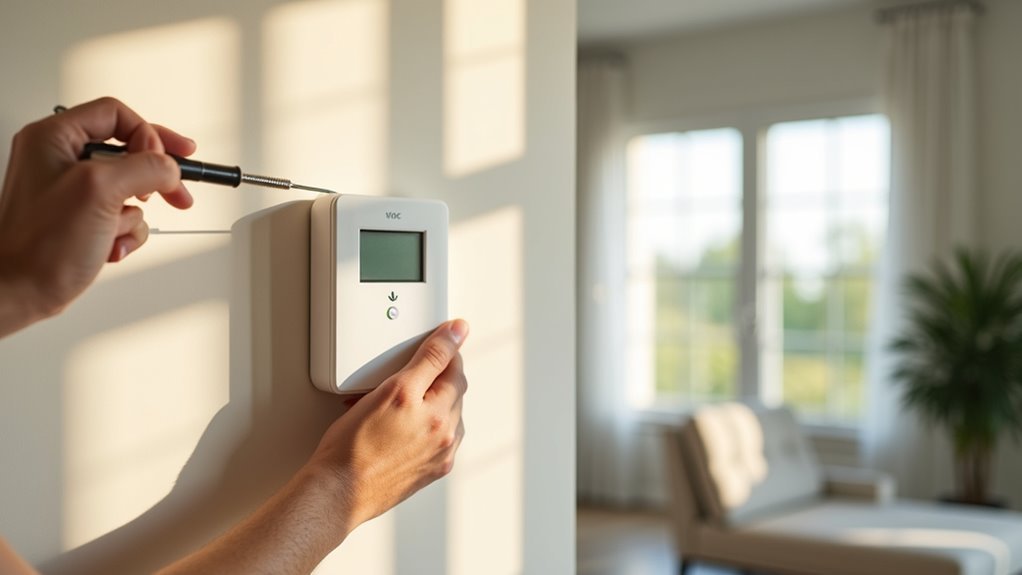
When you’re exposed to VOCs in your home, you’ll face both immediate and long-lasting health consequences that can greatly impact your well-being.
Short-term effects like eye irritation, headaches, and dizziness might seem minor, but they’re warning signs of potentially serious problems ahead.
Understanding these health risks will help you recognize why monitoring your indoor air quality isn’t just beneficial—it’s essential for protecting your family’s health.
Short-Term Health Effects
Although VOC exposure often goes unnoticed until symptoms appear, short-term contact with these chemicals can trigger immediate health problems that’ll disrupt your daily life. You might experience eye irritation, headaches, dizziness, or nausea when VOC levels spike from household products like paints and cleaning supplies.
These symptoms can worsen in poorly ventilated spaces where harmful chemicals accumulate. If you have asthma or respiratory conditions, even low VOC concentrations can trigger attacks and allergic reactions.
High exposure levels pose serious risks to your health, potentially affecting your nervous system, liver, and kidneys. Children and elderly family members face heightened vulnerability to these effects.
That’s why sensor technology becomes essential—you need to monitor the air quality continuously to protect your household from these invisible threats.
Long-Term Health Consequences
While short-term VOC exposure creates immediate discomfort, the real danger lies in what happens when you’re exposed to these chemicals day after day, year after year.
Long-term exposure to VOCs triggers severe health issues that develop gradually over time. You’ll face increased risks of developing cancers, particularly leukemia from benzene exposure and nasopharyngeal cancer from formaldehyde. Your liver, kidneys, and nervous system suffer damage that can lead to neurological disorders.
Studies reveal that chronic VOC inhalation causes cognitive decline and memory impairment. If you’re pregnant, have children, or existing health conditions, you’re especially vulnerable.
This makes effective monitoring through VOC sensors essential for protecting your family’s long-term health and preventing these devastating consequences.
Understanding VOC Sensor Technology Types
| Technology | Detection Method | Best Application |
|---|---|---|
| Metal Oxide (MOS) | Resistance changes in oxide layer | Budget-conscious homeowners |
| Photoionization Detectors (PIDs) | UV light ionization | Fast detection needs |
| Infrared (IR) | Absorption spectroscopy | Specific VOC identification |
| MOS Sensors | Cost-effective monitoring | General air quality tracking |
| IR Sensors | Long-term stability | Precision measurements |
You’ll find MOS sensors offer affordability but struggle with humidity fluctuations. PIDs deliver rapid response times for low-concentration detection, while IR sensors provide exceptional selectivity without drift issues over time.
PID Vs Electrochemical Vs Metal Oxide Sensors
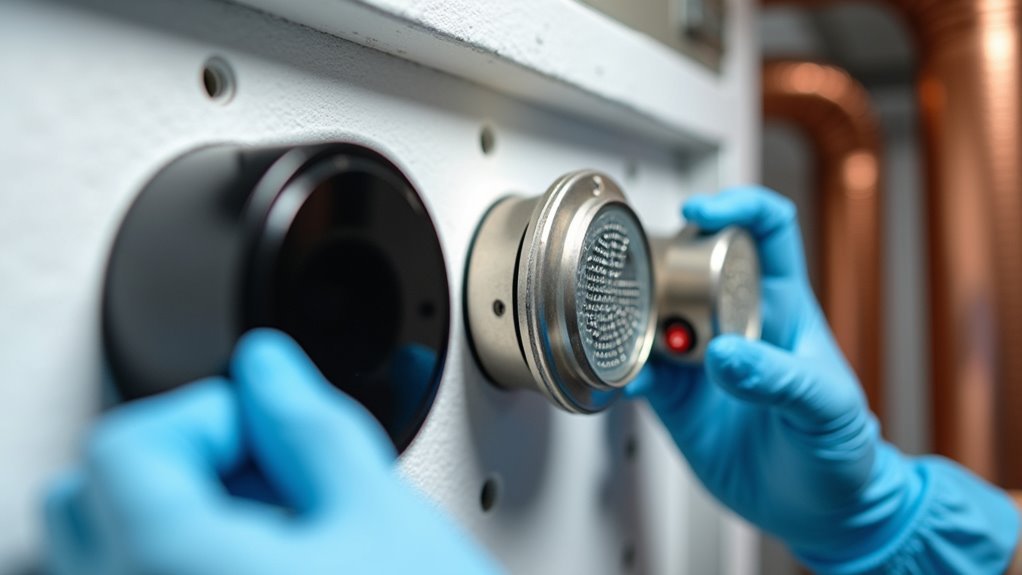
When you’re selecting between PID, electrochemical, and metal oxide sensors, you’ll need to balance sensitivity requirements against your budget and maintenance preferences.
PID sensors offer exceptional precision, detecting VOC concentration as low as 0.001 ppm through ultraviolet light ionization with fast response times.
PID sensors deliver industry-leading precision with 0.001 ppm sensitivity and rapid response through advanced ultraviolet ionization technology.
Electrochemical sensors provide a middle ground at 0.01 ppm sensitivity using electrode reactions, making them budget-friendly options.
MOS sensors deliver cost-effective broad-spectrum detection but suffer from temperature and humidity interference that affects accuracy.
You’ll need regular calibration for both PID and electrochemical sensors to maintain performance, while MOS sensors typically require replacement every two years due to material degradation.
Consider your specific air quality monitoring needs and long-term maintenance costs when choosing.
Best VOC Detectors for Home Installation
Performance matters most when you’re investing in a VOC detector for your home.
The Honeywell RAE System VOC Detector and ION Tiger VOC Gas Detector both feature PID sensors delivering high sensitivity and accuracy for detecting low VOC concentrations.
For electrochemical precision, consider the Forensics Detectors VOC Gas Detector, which provides reliable measurements of indoor VOC levels.
You’ll want real-time monitoring capabilities like those found in the E-Instruments AQ VOC Portable Handheld VOC Monitor. This air quality sensor lets you track changes and identify trends easily.
Avoid cheap detectors with metal oxide sensors—they’re unreliable and lack proper calibration standards.
Install your monitor near VOC sources like kitchens, garages, or workshops for ideal detection and timely alerts.
VOC Detectors to Avoid and Why
You’ll want to steer clear of low-cost VOC detectors priced between $20 and $200, as they typically use unreliable metal oxide sensors that can’t handle temperature and humidity changes.
These budget models often lack proper calibration to national standards, making their readings unstable and non-repeatable when you need accurate air quality data.
Metal oxide sensors are particularly problematic because they’re highly cross-sensitive to other gases, which means you’ll get false positives that make it impossible to trust your VOC measurements.
Low-Cost Sensor Problems
Three critical flaws plague most low-cost VOC detectors in the $20 to $200 range, making them unreliable choices for monitoring your home’s air quality.
First, these VOC sensors using metal oxide technology suffer from severe cross-sensitivity to temperature and humidity changes, causing wildly inaccurate readings that don’t reflect actual contamination levels.
Second, manufacturers typically skip calibration to national standards, resulting in measurements that vary dramatically between devices and over time. You can’t trust data that isn’t consistent or repeatable.
Third, sensor performance degrades considerably as components age, making your detector increasingly ineffective at detecting harmful VOC concentrations.
This degradation creates a dangerous false sense of security—you’ll think your air quality is acceptable when it actually poses health risks requiring immediate attention.
Metal Oxide Limitations
Metal oxide semiconductor sensors represent the worst offender among problematic VOC detection technologies.
These metal oxide sensors suffer from extreme sensitivity to humidity and temperature fluctuations, causing your readings to swing wildly and become completely unreliable measurements. You’ll find that most low-cost VOC sensors use this flawed technology, delivering unstable and non-repeatable results that make accurate air quality monitoring impossible.
The sensors typically last only two years before requiring replacement, creating hidden long-term costs.
Most concerning is their lack of calibration to national standards, meaning you can’t trust their measurements. This unreliability creates serious health risks since you might miss detecting harmful VOC levels in your home, leaving your family exposed to dangerous indoor air pollutants.
Choosing the Right Location for Your VOC Sensors
Since proper placement directly impacts the accuracy of your readings, selecting strategic locations for your VOC sensors requires careful consideration of airflow patterns and emission sources throughout your home.
Position your sensors in areas with high potential for VOC emissions, including kitchens, bathrooms, and spaces near garages where cleaning supplies and paints are stored. Install them at breathing height—approximately 3-5 feet off the ground—to monitor air quality that directly affects occupants.
Avoid placing sensors near vents or windows where drafts can skew readings. Don’t install them in enclosed spaces like closets where limited airflow prevents effective monitoring.
For thorough coverage, use multiple sensors throughout different rooms to identify specific pollution sources and maintain proper placement standards.
Step-by-Step Installation Process
Four essential steps will guide you through installing your VOC sensor properly and efficiently.
First, power your sensor using batteries or a power outlet, then complete the initial setup following manufacturer instructions, including calibration procedures.
Second, mount the sensor securely using provided hardware, positioning it on a wall or flat surface at ideal height for air sampling.
Third, connect your sensor to the required mobile app or monitoring system by following pairing guidelines and configuring data transmission settings.
Fourth, establish a maintenance routine by regularly checking functionality, calibration status, and updating software or firmware.
This systematic installation approach guarantees your air quality monitoring system operates accurately and delivers reliable VOC detection throughout your home.
Integrating VOC Sensors With Smart Home Systems
Once you’ve installed your VOC sensor, you’ll want to connect it with your existing smart home ecosystem to access powerful automation capabilities.
Integration with smart home systems enables real-time air quality monitoring and automatic alerts when VOC levels exceed safe thresholds. Your sensors can communicate with HVAC systems to adjust ventilation automatically, or trigger air purifiers when pollutants are detected.
Advanced VOC sensors support programming specific actions within your smart home network, including mobile app notifications for immediate awareness.
Many platforms utilize machine learning algorithms to analyze sensor data, identifying air quality patterns over time for better health management.
Voice-activated assistants let you query current air quality status and receive personalized advice for improving indoor conditions based on your VOC sensor readings.
Calibrating Your VOC Sensors for Accurate Readings
After completing your smart home integration, proper calibration becomes essential for maintaining accurate VOC readings throughout your sensor’s lifespan.
You’ll need to calibrate your VOC sensors using known calibration gases to guarantee outputs match actual concentrations and prevent sensor drift from compromising data quality.
Follow these calibration best practices:
- Schedule regular calibrations – Perform calibration at least annually, or more frequently based on usage conditions.
- Use manufacturer protocols – Different sensor types (PID vs. electrochemical) require specific procedures.
- Maintain clean connections – Check electrical contacts and clean sensors during calibration.
- Document calibration dates – Track when you’ve performed calibrations to maintain consistent schedules.
Proper calibration combined with regular maintenance appreciably enhances your VOC sensors’ accuracy and extends their operational lifespan.
Interpreting VOC Sensor Data and Alert Levels
With your VOC sensors properly calibrated, you’ll now receive reliable data that requires careful interpretation to protect your home’s air quality.
VOC sensor data appears in parts per million (ppm), showing the concentration of VOCs in your indoor environment. Most sensors use index systems where lower numbers indicate better air quality levels and higher numbers signal increased health risks.
VOC readings in ppm reveal indoor air concentration levels, with lower numbers indicating safer air and higher values warning of potential health risks.
Pay attention to alerts triggered at manufacturer-defined thresholds, as these warn of levels that could cause irritation or long-term health effects.
Understanding which specific compounds your sensor detects helps you interpret readings more effectively, since different VOCs pose varying dangers and originate from different household sources.
Monitor trends regularly to identify patterns and address air quality issues before they become serious health concerns.
Maintenance and Troubleshooting Your VOC Sensors
Your VOC sensors won’t maintain accuracy without regular calibration, which you’ll need to perform according to the manufacturer’s schedule to guarantee reliable readings.
You’ll encounter common issues like sensor drift, contaminated surfaces, and inconsistent alerts that can compromise your air quality monitoring.
Recognizing these problems early and following proper troubleshooting steps will keep your sensors functioning effectively and extend their operational lifespan.
Regular Calibration Requirements
Since VOC sensors naturally drift over time, you’ll need to establish a regular calibration schedule to maintain accurate readings. This process involves using known calibration gases to match your sensor’s output with established VOC levels, guaranteeing your air quality monitoring remains reliable.
Follow these calibration requirements:
- Calibrate annually minimum – or more frequently if sensors face harsh conditions
- Use manufacturer-specified calibration gases that match your monitoring needs
- Perform maintenance during calibration – clean sensors and check electrical connections
- Follow manufacturer guidelines strictly to avoid sensor damage
Your calibration frequency should increase for critical monitoring applications. Without proper calibration, VOC sensors can provide false readings that compromise your home’s air quality assessment.
Regular calibration combined with routine maintenance guarantees peak sensor performance and protects your family’s health.
Common Sensor Issues
Even with proper calibration schedules in place, VOC sensors can develop various performance issues that affect their accuracy and reliability.
Sensor drift remains the most common problem, causing readings to become increasingly inaccurate over time despite regular calibration efforts.
You’ll also encounter contamination buildup on sensor surfaces, which interferes with detection capabilities and requires thorough cleaning during maintenance routines.
Temperature and humidity fluctuations notably impact sensor performance, potentially causing delayed response times or false readings.
Cross-sensitivity presents another challenge, where your sensor responds to non-target gases, making it difficult to interpret actual VOC levels accurately.
Additionally, loose electrical connections and worn components can cause intermittent failures or complete sensor malfunctions, emphasizing the importance of following manufacturer maintenance guidelines consistently.
Reducing VOC Levels Based on Sensor Feedback
Taking action when your VOC sensors detect elevated levels can dramatically improve your home’s air quality and protect your family’s health.
When sensors indicate high concentrations of volatile organic compounds, you’ll need strategic responses to reduce VOC emissions and combat indoor air pollution effectively.
Here are four proven methods to lower VOC levels based on sensor readings:
- Increase ventilation by opening windows or running exhaust fans when sensors show elevated readings.
- Deploy air purifiers with activated carbon filters in rooms reporting high concentrations.
- Switch to low-VOC products for paints, cleaners, and furniture after identifying emission sources.
- Maintain your sensors regularly to guarantee accurate readings and timely responses.
Monitor your VOC sensors consistently and respond quickly to readings above normal thresholds for best results.
Frequently Asked Questions
Which Sensors Are Effective at Detecting VOCS?
You’ll find PIDs most effective, detecting VOCs down to 0.001 ppm using ultraviolet light. Electrochemical sensors work well too, reaching 0.01 ppm sensitivity affordably. Avoid MOS sensors since they’re temperature-sensitive.
What Controls Sensors Could Be Used to Improve Indoor Air Quality?
You can integrate smart HVAC systems, automated air purifiers, humidity controls, and lighting adjustments with VOC sensors. These connected devices automatically respond to air quality data, optimizing ventilation and filtration when needed.
Are Air Quality Sensors Worth It?
Yes, you’ll find air quality sensors worthwhile since they detect harmful chemicals at extremely low concentrations, provide real-time data for immediate action, and help you maintain healthier indoor environments, especially protecting vulnerable family members.
Where Do You Put an Air Quality Sensor?
You should place air quality sensors in high-usage areas like bedrooms and living rooms at breathing height. Don’t position them near windows, doors, or vents where drafts can affect readings.

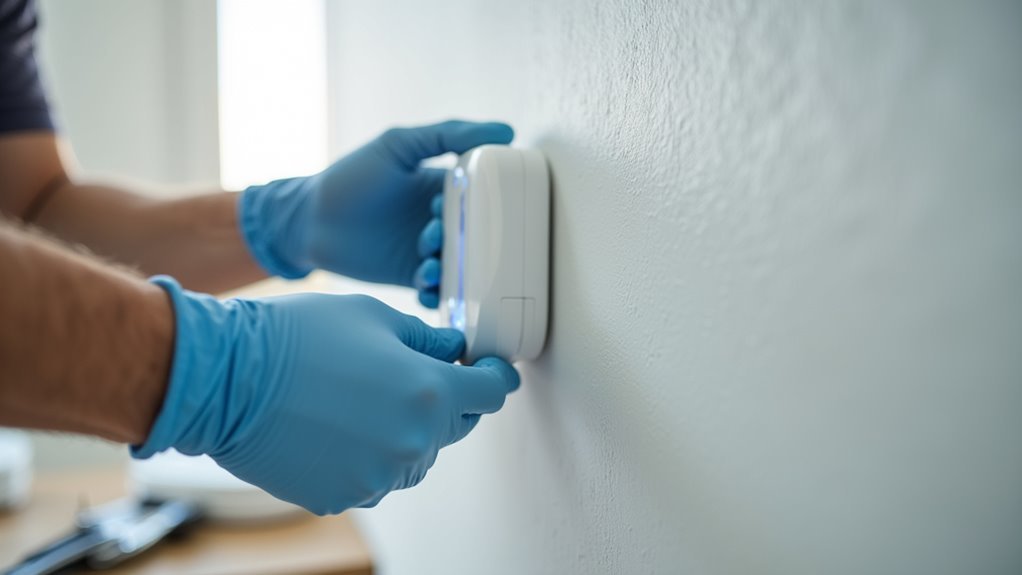


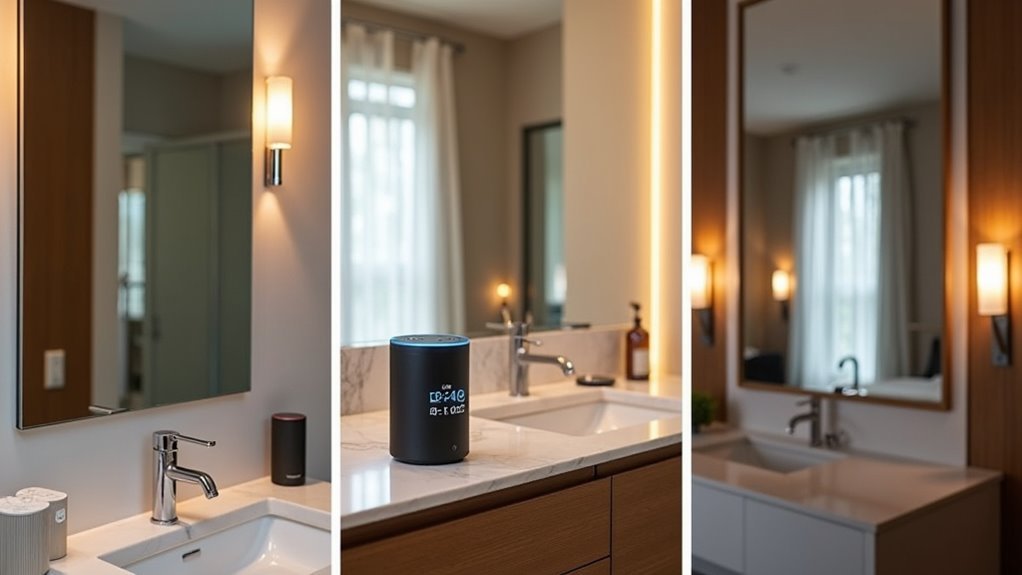
Leave a Reply